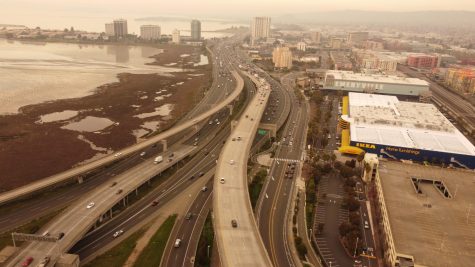Emeryville’s blueprint to a better Bay Area
Less freeways, more housing
More stories from Cedar Makhijani
The Bay Area is in trouble. Rents which, according to apartment listing website Zumper, are the second-highest in the country, continue to rise. Rising rents are pricing the artists, craftsmen, immigrants and other groups who made the Bay Area what it is—a hub of culture, innovation and diversity—out. Traffic is bad and BART data shows ridership is lacking, housing is in short supply and high demand, and homelessness is rampant. The solution? Planners and advocates argue we need to densify the region’s cities: convert single-family homes to duplexes or triplexes, and build higher and more affordable developments closer to the city centers.
John Bauters, Mayor of Emeryville—the city building more affordable housing than any other city in the Bay Area —says that other cities should embrace Emeryville’s approach to building affordable housing. Emeryville makes public land available to developers only if the developer agrees to build enough affordable housing to meet the city’s housing goals. Emeryville also maintains ownership of the land. Instead of selling to developers, the Emeryville City Council grants multi-decade land leases to developers with contracts that allow them to rip down or change the building at the end of the lease to build more affordable housing or densify further if necessary.
Bauters says that selling densification and building up isn’t hard. Densification and big housing developments almost always face fierce opposition, and therefore effectively dealing with opposition is hugely important to accomplishing these goals.When his plans have faced opposition, he lets those who oppose developments know their perspectives are heard. Bauters says that most times, making residents feel heard is enough to satisfy them. Opponents of these housing developments often point to potential problems like increased traffic and lack of parking, which Bauters says rarely manifest.
Bauters says that he agrees to address problems if they actually materialize, which he says is enough to get approval from residents. He believes that avoiding devoting energy, time and funds to solving problems that don’t yet—and may never—exist is critical to getting these projects done.
Bauters notes that fears of increased traffic, while legitimate, are misguided, because if housing isn’t built in cities it would be built in suburbs, creating a larger commuter population, making traffic even worse. Therefore, Bauters believes that the lack of affordable housing makes traffic worse.
Public transit is a commonly proposed solution to traffic. However, California still pours billions into maintaining and expanding roads every year, encouraging sprawl and car-dependency. And, when money is proposed for transit projects, pushback is all but guaranteed.
Bauters attributes this pushback to a social centering of car-operators. “We spend billions and billions of dollars in this state every year repairing roads. If we actually charged users of the roads for the cost of maintaining the system, their gas tax, their tolls, their vehicle registration, all those things would be astronomically higher than they are. But instead we don’t charge them for that,” said Bauters. As a result, drivers are accustomed to a world shaped around them, with unlimited parking, wide and destructive freeways, and high speed limits, all of which are expensive.
Bauters said “[drivers] externalize (don’t directly pay) all this cost because [they] still pay a gas tax and a vehicle registration fee.’ But most users of that system have no idea that that system is not at all financed by them.” Bauters says that the money for roads comes from a lot of places, like the general fund, which he believes can be better spent on other programs. “And the reality is that if you so much as suggest giving money to a transit agency, people immediately say it’s a failure,” said Bauters. “It’s a problem that we expect our transit system to turn a profit when we don’t expect that of roads.”

Having all these people on the road is costly, he says. “I live right next to the maze,” said Bauters, referring to the MacArthur Maze, a large and complicated highway interchange immediately east of the Bay Bridge. “I see people sit on it all day in their cars and trucks. It slows down our goods movement.”
“And yet, we continue to coddle this thing along and siphon billions of dollars out of our annual revenues and budget to keep this giant archaic structure alive. If that same investment was made meaningfully into transit, we would much more effectively and efficiently move people around this region.”
To reform the Bay Area’s transit systems, the cities need to work around the things they already have: BART owns massive amounts of land around its stations, many of which it is pursuing transit-oriented developments (TODs) on. TODs around stations like MacArthur, provide affordable housing and transit connections, as well as income for the agency, which Seung Lee, a digital media specialist at BART, says allow people to both live somewhere affordable and not have to endure a costly commute by car to their workplace while providing more ridership and turning otherwise unused land into something productive. TODs are also dense by default.
“I think the vast majority of people are in support of translating development,” Lee said in an exclusive interview with The Urban Legend. In most cases, no new land acquisition is needed and developers are eager to work on these projects.
It’s clear that to fight the climate crisis, save our cities and ensure a better future, the Bay needs to get building. The newly passed Bipartisan Infrastructure Framework, a $500 billion bill, which makes billions available for housing, transit and climate resiliency projects, will allow the Bay Area an opportunity to employ densification and expand transit.

